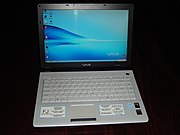 Japanese robots enter daily life
Japanese robots enter daily lifeHooked up to a database of words clustered by association, the robot — dubbed Kansei, or "sensibility" — responds to the word "war" by quivering in what looks like disgust and fear. It hears "love," and its pink lips smile.
"To live among people, robots need to handle complex social tasks," said project leader Junichi Takeno of Meiji University. "Robots will need to work with emotions, to understand and eventually feel them.
While robots are a long way from matching human emotional complexity, the country is perhaps the closest to a future — once the stuff of science fiction — where humans and intelligent robots routinely live side by side and interact socially.
Robots are already taken for granted in Japanese factories, so much so that they are sometimes welcomed on their first day at work with Shinto religious ceremonies. Robots make sushi. Robots plant rice and tend paddies.
There are robots serving as receptionists, vacuuming office corridors, spoon-feeding the elderly. They serve tea, greet company guests and chatter away at public technology displays. Now start-ups are marching out robotic home helpers.
They aren't all humanoid. The Paro is a furry robot seal fitted with sensors beneath its fur and whiskers, designed to comfort the lonely, opening and closing its eyes and moving its flippers.
For Japan, the robotics revolution is an imperative. With more than a fifth of the population 65 or older, the country is banking on robots to replenish the workforce and care for the elderly.
In the past several years, the government has funded a plethora of robotics-related efforts, including some $42 million for the first phase of a humanoid robotics project, and $10 million a year between 2006 and 2010 to develop key robot technologies.
The government estimates the industry could surge from about $5.2 billion in 2006 to $26 billion in 2010 and nearly $70 billion by 2025.
Besides financial and technological power, the robot wave is favored by the Japanese mind-set as well.
Robots have long been portrayed as friendly helpers in Japanese popular culture, a far cry from the often rebellious and violent machines that often inhabit Western science fiction.
This is, after all, the country that invented Tamagotchi, the handheld mechanical pets that captivated the children of the world.
Japanese are also more accepting of robots because the native Shinto religion often blurs boundaries between the animate and inanimate, experts say. To the Japanese psyche, the idea of a humanoid robot with feelings doesn't feel as creepy — or as threatening — as it might do in other cultures.
Still, Japan faces a vast challenge in making the leap — commercially and culturally — from toys, gimmicks and the experimental robots churned out by labs like Takeno's to full-blown human replacements that ordinary people can afford and use safely.
"People are still asking whether people really want robots running around their homes, and folding their clothes," said Damian Thong, senior technology analyst at Macquarie Bank in Tokyo.
"But then again, Japan's the only country in the world where everyone has an electric toilet," he said. "We could be looking at a robotics revolution."
That revolution has been going on quietly for some time.
Japan is already an industrial robot powerhouse. Over 370,000 robots worked at factories across Japan in 2005, about 40% of the global total and 32 robots for every 1,000 Japanese manufacturing employees, according to a recent report by Macquarie, which had no numbers from subsequent years.
And they won't be claiming overtime or drawing pensions when they're retired.
"The cost of machinery is going down, while labor costs are rising," said Eimei Onaga, CEO of Innovation Matrix Inc., a company that distributes Japanese robotics technology in the U.S. "Soon, robots could even replace low-cost workers at small firms, greatly boosting productivity."
That's just what the Japanese government has been counting on. A 2007 national technology roadmap by the Trade Ministry calls for 1 million industrial robots to be installed throughout the country by 2025.
A single robot can replace about 10 employees, the roadmap assumes — meaning Japan's future million-robot army of workers could take the place of 10 million humans. That's about 15% of the current workforce.
"Robots are the cornerstone of Japan's international competitiveness," Shunichi Uchiyama, the Trade Ministry's chief of manufacturing industry policy, said at a recent seminar. "We expect robotics technology to enter even more sectors going forward."
Meanwhile, localities looking to boost regional industry clusters have seized on robotics technology as a way to spur advances in other fields.
Robotic technology is used to build more complex cars, for instance, and surgical equipment.
The logical next step is robots in everyday life.
At a hospital in Aizu Wakamatsu, 190 miles north of Tokyo, a child-sized white and blue robot wheels across the floor, guiding patients to and from the outpatients' surgery area.
The robot, made by start-up Tmsk, sports perky catlike ears, recites simple greetings, and uses sensors to detect and warn people in the way. It helpfully prints out maps of the hospital, and even checks the state of patients' arteries.
The Aizu Chuo Hospital spent about some $557,000 installing three of the robots in its waiting rooms to test patients' reactions. The response has been overwhelmingly positive, said spokesman Naoya Narita.
"We feel this is a good division of labor. Robots won't ever become doctors, but they can be guides and receptionists," Narita said.
Still, the wheeled machines hadn't won over all seniors crowding the hospital waiting room on a weekday morning.
"It just told us to get out of the way!" huffed wheelchair-bound Hiroshi Asami, 81. "It's a robot. It's the one who should get out my way."
"I prefer dealing with real people," he said.
Another roadblock is money.
For all its research, Japan has yet to come up with a commercially successful consumer robot. Mitsubishi Heavy Industries Ltd. failed to sell even one of its pricey toddler-sized Wakamaru robots, launched in 2003 as domestic helpers.
Though initially popular, Sony Corp. pulled the plug on its robot dog, Aibo, in 2006, just seven years after its launch. With a price tag of a whopping $2,000, Aibo never managed to break into the mass market.
One of the only commercially successful consumer robots so far is made by an American company, iRobot Corp. The Roomba vacuum cleaner robot is self-propelled and can clean rooms without supervision.
"We can pretty much make anything, but we have to ask, what are people actually going to buy?" said iRobot CEO Helen Greiner. The company has sold 2.5 million Roombas — which retail for as little as $120 — since the line was launched in 2002.
Still, with the correct approach, robots could provide a wealth of consumer goods, Greiner stressed at a recent convention.
Sure enough, Japanese makers are catching on, launching low-cost robots like Tomy's $300 i-Sobot, a toy-like hobby robot that comes with 17 motors, can recognize spoken words and can be remote-controlled.
Sony is also trying to learn from past mistakes, launching a much cheaper $350 rolling speaker robot last year that built on its robotics technology.
"What we need now isn't the ultimate humanoid robot," said Kyoji Takenaka, the head of the industry-wide Robot Business Promotion Council.
"Engineers need to remember that the key to developing robots isn't in the lab, but in everyday life."
Still, some of the most eye-catching developments in robotics are coming out of Japan's labs.
Researchers at Osaka University, for instance, are developing a robot to better understand child development.
The "Child-Robot with Biomimetic Body" is designed to mimic the motions of a toddler. It responds to sounds, and sensors in its eyes can see and react to people. It wiggles, changes facial expressions, and makes gurgling sounds.
The team leader, Minoru Asada, is working on artificial intelligence software that would allow the child to "learn" as it progresses.
"Right now, it only goes, 'Ah, ah.' But as we develop its learning function, we hope it can start saying more complex sentences and moving on its own will," Asada said. "Next-generation robots need to be able to learn and develop themselves."
For Hiroshi Ishiguro, also at Osaka University, the key is to make robots that look like human beings. His Geminoid robot looks uncannily like himself — down to the black, wiry hair and slight tan.
"In the end, we don't want to interact with machines or computers. We want to interact with technology in a human way so it's natural and valid to try to make robots look like us," he said.
"One day, they will live among us," Ishiguro said. "Then you'd have to ask me: 'Are you human? Or a robot?"'














 Delicious
Delicious Digg
Digg StumbleUpon
StumbleUpon Reddit
Reddit Newsvine
Newsvine Facebook
Facebook Google
Google Yahoo
Yahoo




















Nice post
nice post...
try to give a two line describer about the post.